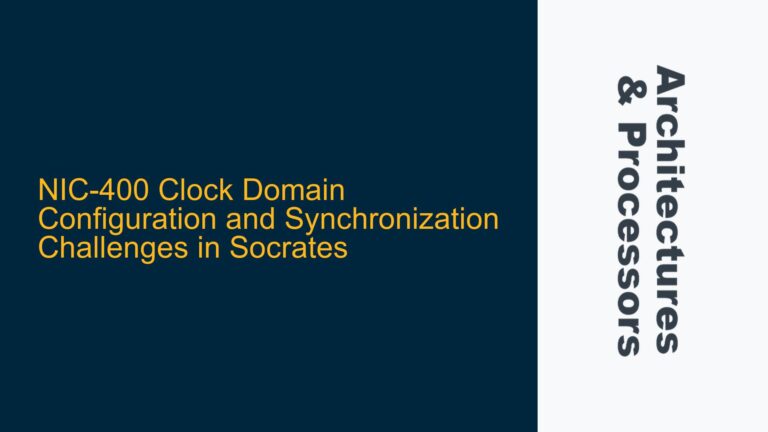ARM Cortex-A53 PM_CCNTR Behavior During WFI and CPU Load Estimation
The ARM Cortex-A53 processor, part of the ARMv8-A architecture, includes a Performance Monitoring Unit (PMU) that provides various counters to measure system performance. One such counter is the PM_CCNTR (Performance Monitor Cycle Counter), which increments at the frequency of the CPU clock. The PM_CCNTR can be used to measure CPU load by observing its behavior during different operational states, particularly during the execution of the Wait For Interrupt (WFI) instruction. When the WFI instruction is executed, the core clock halts, causing the PM_CCNTR to stop incrementing. This behavior can be leveraged to estimate CPU load by periodically sampling the PM_CCNTR and calculating the difference between consecutive samples.
The methodology proposed involves sampling the PM_CCNTR at regular intervals, such as every 10 milliseconds, and using the difference in counts between samples to infer CPU load. For instance, if the core is operating at 1 GHz, a 10-millisecond interval should ideally result in 10,000,000 counts if the CPU is fully utilized. If the observed count difference is 7,000,000, this implies that the core was idle for 30% of the time, corresponding to a CPU load of 70%. This approach assumes that the only factor causing the PM_CCNTR to stop incrementing is the execution of the WFI instruction.
However, this methodology relies on several assumptions and requires careful consideration of factors that could influence the PM_CCNTR behavior. These factors include the potential for CPU throttling, the impact of other power-saving states, and the accuracy of the sampling mechanism. Understanding these factors is crucial to ensure that the PM_CCNTR-based CPU load measurement is accurate and reliable.
Potential Influences on PM_CCNTR Behavior Beyond WFI Execution
While the WFI instruction is a primary factor that halts the core clock and stops the PM_CCNTR from incrementing, there are other scenarios and system behaviors that could affect the PM_CCNTR counts. One such factor is CPU throttling, which can occur in response to thermal conditions or power management policies. Throttling reduces the CPU clock frequency, which in turn affects the rate at which the PM_CCNTR increments. If the CPU is throttled, the PM_CCNTR will increment more slowly, leading to an underestimation of CPU load if the throttling is not accounted for.
Another consideration is the presence of other low-power states that the CPU might enter, such as retention or shutdown states, which could also halt the core clock. These states are typically managed by the operating system or power management firmware and may not be directly visible to the application code. If the CPU enters such a state, the PM_CCNTR will stop incrementing, similar to the effect of the WFI instruction. However, these states are often entered in response to specific conditions, such as prolonged idle periods, and may not be directly tied to the execution of WFI.
Additionally, the accuracy of the sampling mechanism itself is critical. The PM_CCNTR must be sampled at precise intervals to ensure that the calculated CPU load is accurate. Any jitter or delay in the sampling process can introduce errors in the load estimation. Furthermore, the PM_CCNTR is a 64-bit counter, and care must be taken to handle potential overflow conditions, especially if the sampling interval is long or the CPU frequency is high.
Ensuring Accurate CPU Load Measurement Using PM_CCNTR
To ensure accurate CPU load measurement using the PM_CCNTR, several steps must be taken to address the potential influences on the counter’s behavior. First, it is essential to confirm that the operating system or firmware does not implement CPU throttling or other power-saving mechanisms that could affect the PM_CCNTR. This can be done by reviewing the system configuration and power management policies, as well as monitoring the CPU clock frequency during operation.
Next, the sampling mechanism must be carefully implemented to minimize jitter and ensure precise timing. This can be achieved by using a high-resolution timer or a dedicated hardware timer to trigger the PM_CCNTR sampling at regular intervals. The sampling interval should be chosen based on the desired granularity of the CPU load measurement and the expected range of CPU utilization. For example, a 10-millisecond interval provides a good balance between granularity and overhead for a 1 GHz CPU.
Handling PM_CCNTR overflow is another critical aspect. Since the PM_CCNTR is a 64-bit counter, overflow is unlikely to occur in most practical scenarios. However, if the sampling interval is very long or the CPU frequency is extremely high, overflow could become a concern. To address this, the sampling code should include logic to detect and handle overflow conditions, ensuring that the calculated count difference is always correct.
Finally, it is important to validate the PM_CCNTR-based CPU load measurement against other methods, such as operating system-provided load averages or performance profiling tools. This validation helps to confirm the accuracy of the PM_CCNTR-based approach and identify any discrepancies that may arise due to unaccounted factors. By addressing these considerations and implementing the necessary safeguards, the PM_CCNTR can be effectively used to measure CPU load on the ARM Cortex-A53 processor.
In conclusion, the PM_CCNTR provides a valuable mechanism for estimating CPU load on the ARM Cortex-A53, particularly in systems where the WFI instruction is used to manage idle states. However, accurate measurement requires careful consideration of factors such as CPU throttling, other low-power states, and sampling accuracy. By addressing these factors and implementing robust sampling and overflow handling mechanisms, the PM_CCNTR can be a reliable tool for CPU load measurement in embedded systems.






